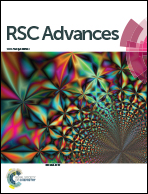Protonated mesoporous graphitic carbon nitride for rapid and highly efficient removal of microcystins†
Abstract
Cyanotoxins have caused worldwide concern due to their diverse occurrence and toxic effects, which has led to an intensive search for cost-effective techniques for their removal from contaminated water. In this study, a novel biomaterial, protonated mesoporous graphitic carbon nitride (mpg-C3N4–H+) which is fabricated by treating mpg-C3N4 with concentrated hydrochloric acid, is applied as a promising bioadsorbent for the uptake of microcystins (MCs). The pH of the reaction media played a significant role in the removal of MCs; maximum adsorption occurred at pH 7. Kinetic studies showed that the adsorption of MC-LR and MC-RR onto the adsorbent was a rapid process. The mpgH+ exhibited high adsorption capacities of 2360.96 and 2868.78 μg g−1 from the Langmuir model for MC-LR/RR, respectively. The high adsorption capacity, good solvent stability, and excellent reusability make mpg-C3N4–H+ promising as a novel adsorbent for the adsorption and removal of MCs from aqueous solution. This information may be useful for further research and practical applications of the novel two-dimensional layered, mesoporous graphitic carbon nitride.


 Please wait while we load your content...
Please wait while we load your content...